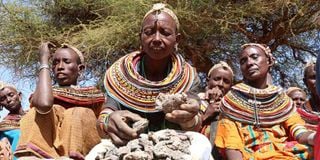In dry northern Kenya, thorny acacia changes fortunes

Residents of Ndigir village in Marsabit County sort gum collected from acacia trees. PHOTO | NICHOLAS KOMU | NATION MEDIA GROUP
For generations, pastoral communities in Northern Kenya knew no other source of livelihood besides livestock.
To them, the acacia tree, which dots the region, was nothing more than a source of wood, fodder and shade.
What they never realised was that they have been sitting on hundreds of thousands of acres of unexplored treasure, capable of changing the fortunes of a region characterised by hunger and poverty.
This was until a few years ago when foreign buyers came knocking. Global companies dealing in soft drinks, paint and cosmetics, consider the contents of this desert tree a crucial component to the thriving multibillion shilling industries. Residents of Marsabit, Wajir and Madera counties are gradually taking an interest in the lucrative trade in gum and resin.
Gum and resin are dried sap from specific acacia trees. These products are in your favourite fizzy drink, whether it’s a Coca Cola product or Pepsi, in cosmetics and even in pharmaceutical drugs.
Products from the acacia tree are of high value in the international and local markets.
HIGH DEMAND
For instance, the lowest paying product currently being collected from Northern Kenya is one which fetches between Sh150 and Sh200 per kilo. The best paying product is opoponax, commonly referred to as sweet myrrh - a gum resin on high demand for medicinal uses especially in Asian countries. A kilo of the sweet myrrh costs between Sh900 and Sh1,500 locally.
An added advantage to the recently discovered venture is that the acacia trees actually produce the best quality products under stress with very little rainfall. This means that dry seasons will no longer be dreaded should locals fully embrace the venture.
“We did not know how important the trees are and how we can benefit from gum and resin. Some middlemen buying for exporters introduced the idea and we realised that we have a lot of wealth besides livestock,” Mr Wilfred Longelesh, a resident of Laisamis in Marsabit County, tells HealthyNation.
Today, the community in Laisamis sub-county has formed Laisamis Gums and Resins Marketing Association, a group that markets and trains residents on four key products from four species of the acacia tree.
The most common of the products is Gum Arabic, collected from the Acacia Senegal species. The gum is used as a bonding agent and emulsifier in soft drinks. It keeps the sugar from separating and crystalising after bottling. It is also used as a binder for pharmaceutical drugs, sweets and chewing gum as well as cosmetics.
FETCHES MILLIONS
At optimal conditions, the best trees can produce up to 1.5kg per day. “We make the cuts and leave the trees untouched for about two weeks. This gives the gum enough time to solidify,” says Mr Longelesh.
Through the association, the communities sell the gum collectively for between Sh150 and Sh200 per kilo.
Gum Arabic is a huge product especially in Europe and America where Sudan is the largest supplier, accounting for up 70 per cent of the global supply. According to a report by United Nations Conference on Trade and Development, Sudan exported two thirds of the gum globally in 2018.
So crucial is the product to the world beverage industry that the US specifically exempted it from the economic sanctions it imposed on Sudan in 1997. The country earned more than $80million (Sh8 billion) from exporting 41,397 tonnes of Gum Arabic in 2011.
Myrrh and frankincense are two other key products fetching millions of shillings.
Myrrh is harvested from Commiphora Altisiana species of the acacia tree. Its harvesting is similar to that of the gum as it is also dried sap. Locals identify it as Hur, which was traditionally used as an acaricide. “We apply this on cows to get rid of ticks. Ironically, its industrial use is to make acaricides,” Mr Longelesh explains.
Due to high demand, myrrh fetches up to Sh550 per kilogramme locally. Frankincense is a product of the Bosoellia Neglecta acacia species and is used in the industrial production of perfumes. The community refer to it as Luban and used to burn it during traditional ceremonies for its scent.
TAX JITTERS
In modern communities, the wood from the tree is burned to produce the scented smoke used commonly by Catholic priests during mass. The product fetches between Sh120 and Sh200 locally.
Gum and resin exporter and expert Tommaso Menini says China has created the huge demand for opoponax, which is used in traditional medicine. “Chinese agents have been setting up in Kenya looking for the sweet myrrh and they are willing to pay highly for it,” he says.
Locals who harvest the sweet myrrh have been selling it for up to a staggering Sh1,500 per kilogram. The product will fetch up to Sh4,000 per kilo on the global market.
Marsabit County Government has already taken interest in the venture, providing technical training on environmental conservation of the trees to ensure sustainability of the business.
Assistant Director of Environment and Natural Resources Janet Ahatho says the venture has been captured in the County Intergrated Development Plan.
Like any other export product in the country, middlemen and brokers are a concern for both locals and exporters. “Middlemen do not necessarily add value to the value chain, but some are important in linking collectors to the buyers,” Mr Menini argues.
Another emerging challenge is the lack of regulations and policies to govern the gum and resin trade. However, some traders remain jittery of the level of taxation the country may impose on the trade considering its potential income.


